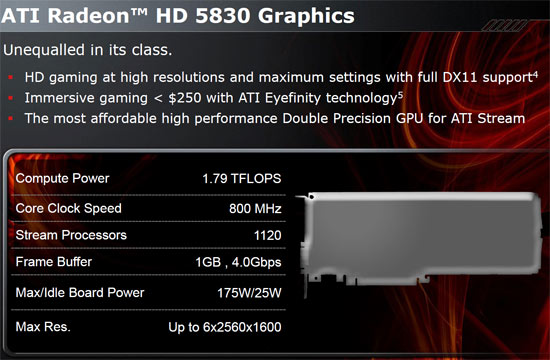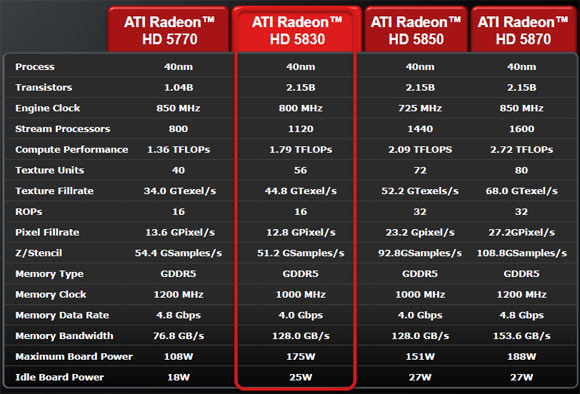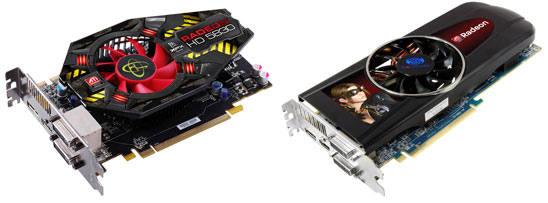ATI Radeon HD 5830 1GB DX11 Video Card Review
The $239 Radeon HD 5830 GDDR5 GPU

ATI has ten Radeon HD 5000 series graphics cards on the market today, and if you think they are going to stop there you are sadly mistaken. Today AMD is announcing the Radeon HD 5830 graphics card, which is the ‘big brother’ of the $143 Radeon HD 5770 and the ‘little brother’ of the $299 Radeon HD 5850. Priced right in the middle at $239 the Radeon HD 5830 helps bridge the performance and the price gap between what many of our readers would consider the entry level gamer graphics cards and the mainstream gamers’ card.
The Radeon HD 5830 is a derivative of the Radeon HD 5870 and is identical not only in size, but also general features. The ATI Radeon HD 5870 has 20 SIMD engines that each have 16 Thread
Processors. A thread processor contains 5 stream cores, so this is how
the Radeon HD 5870 has 1600 total stream processors. The Radeon HD 5830 has six of the 20 SIMD engines turned off, so it has a total of 14 functional SIMD engines. This means that the Radeon HD 5830 has 1120 stream processors. A light should have just gone off inside your head right about now and it should be telling you that the Radeon HD 5830 has been created from the silicon that didn’t make the grade to become a Radeon HD 5870. Nothing is wrong with this practice, but since we’ve already reviewed 10 Radeon HD 5000 series cards in the past we’ll skip the basic features and get right to what has changed and then move on to the benchmarks.

The specifications of the Radeon HD 5830 video card are decent for
the planned $230 price point. As you can see the Radeon HD 5830 fits between the Radeon HD 5770 and HD 5850 graphics cards. It has the same number of transistors as the other Radeon HD 5000 series cards, but has fewer stream processors and half the ROPs. With just 1120 stream processors the Radeon HD 5830 has 22% less stream processors than the Radeon HD 5850, but tries to make up for it with a higher clock frequency on the stream processors that it does have. By running at 800MHz rather than 725MHz it gets a 10.3% performance boost on the remaining stream processors. This means that that the overall compute performance of the Radeon HD 5830 is an impressive 1.79 TFLOPs, which is 14.4% behind the Radeon HD 5850. Not bad looking!
The render backend, though, gets hammered since it has only 16 ROPs rather than the 32 found on the Radeon HD 5850 and Radeon HD 5870. It also has 56 texture units, which is 22% fewer than on the Radeon HD 5850. The end result here is that the pixel fillrate and z/stencil performance is nearly half that of the Radeon HD 5850 … very interesting. We basically have a Radeon HD 5850 that had some faulty locations in chips that were disabled, the engine clock was then overclocked to increase the compute performance and a new card is being launched. This is good in the sense that the core ASIC isn’t going to waste, but the card does have one downfall — it has higher power consumption than the Radeon HD 5850 since the Radeon HD 5830 has increased core voltages that are needed to reach the higher core clock speeds. The end result is a card that is cheaper and less powerful than the Radeon HD 5850, but also one that also uses more power.

The ATI Radeon HD 5830 is based on a currently existing AIB/ASIC model, and as a result you will see the ATI Radeon HD 5830 shipping with customized AIB boards right from the start. Shown above are the XFX and Radeon HD 5830 graphics cards with custom cooling solutions on them. The card that we are reviewing today is a reference design from AMD, so it looks just like a Radeon HD 5870. Let’s take a look at the card and then get to the benchmarks.

Comments are closed.